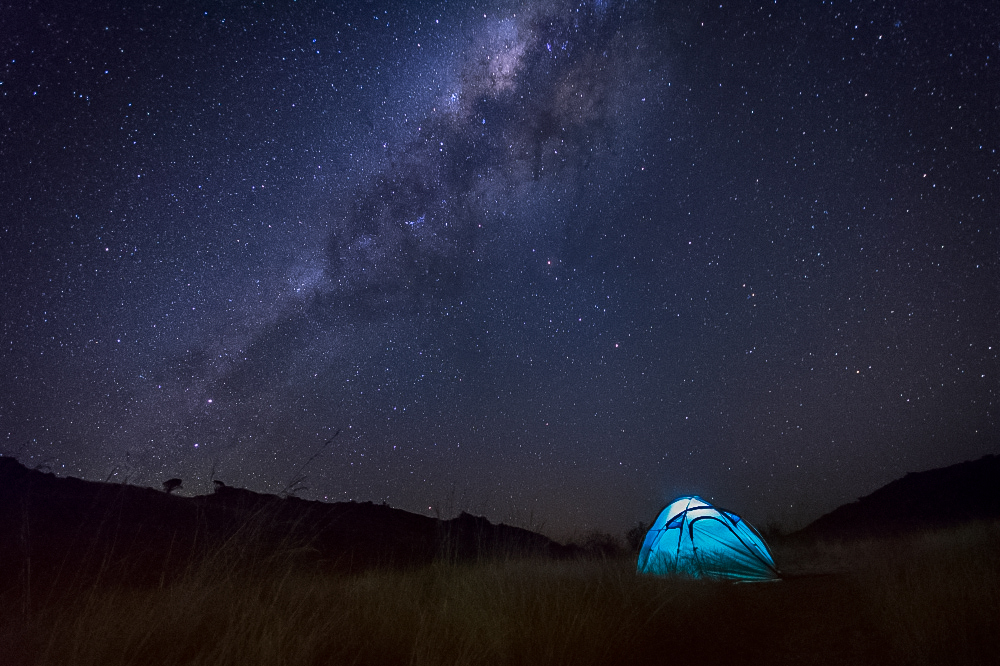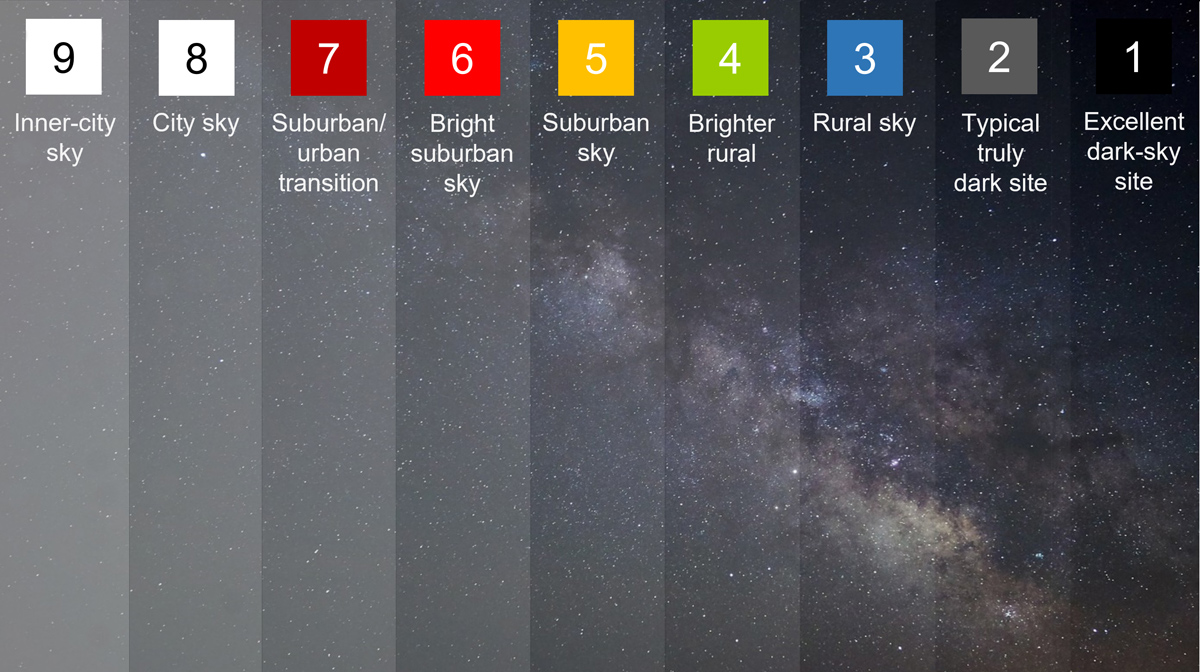Dark Sky Sites in the UK That You Should Visit for Unforgettable Views of the Night Sky

The UK is one of the few places in Europe where you can experience truly dark skies.
Despite a thriving population, large cities and increasing light pollution, the UK surprisingly contains several internationally recognised and protected dark sky sites. Its unique location in the North Atlantic positions it favourably away from the densely populated areas of mainland Europe and if you travel to its more remote regions, you too can experience pristine views of the night sky.
So, if you are tired of light-polluted skies, read on to discover some of the best dark-sky locations in the UK.
What are Dark Skies?
Before we jump into the list it is worth summarising how sky darkness is categorised. This will help you understand what to expect from a specific location under moonless skies.
The most popular way to classify sky darkness is to use the Bortle scale.
The Bortle scale ranks sky darkness on a scale from 1 to 9. The lower the number the less light pollution and the darker the sky will appear. The best dark skies are remote rural skies at Bortle class 3 or better, the UK even boasts several Bortle 1 and 2 locations.
The image below gives a visual illustration of the Bortle scale and the effect of light pollution on the night sky.

Visualisation of light pollution using the Bortle scale
What does this mean for you when viewing the night sky? What astronomical objects might you expect to see from a city? From the suburbs? Or from a rural dark-sky location?
Heavily light-polluted City Skies – Bortle Class 7/8/9
In the centre of brightly lit inner cities, the sky is completely washed-out.
Many stars are invisible, and, in some cities, the light pollution is so bad that the only objects you might reliably see are the Moon, planets and a few of the brightest stars. The Milky Way is not visible, and binoculars and telescopes will only marginally improve things for you.
Light-polluted Suburban Skies – Bortle Class 5/6
Moving out to more sparsely populated areas, like the suburbs, things improve but are still far from ideal.
You will be able to make out more constellations as more stars are visible but for faint constellations, such as URSA minor, it will be difficult to spot all the stars. The Milky Way is barely visible, it will be difficult and vague to spot and possibly only visible directly overhead.
Dark Rural Skies – Bortle Class 3/4
Once you start to move further away from built-up areas the sky becomes more striking.
There is still light pollution at the horizon and light domes from nearby cities create a sky glow in the direction of the city. The milky way becomes much more impressive with detail and structure now visible. Some of the brighter galaxies and nebula are now easy naked-eye objects, such as the Andromeda Galaxy and the Great Orion nebula.
Truly Dark Skies – Bortle Class 1/2
A truly dark, moonless, sky is an unforgettable experience.
There are astronomical features that become visible to the naked eye under dark skies, such as the zodiacal light and the lesser-known Gegenschein. The irony of such dark skies is that there are so many more stars visible that even faint constellations become difficult to spot amongst the sheer number of stars that can be seen.
The Milky Way is very easy to see and will appear bright and highly structured. In certain places, the Milky Way can be so bright that it can even cast shadows!
Dark Sky Sites in the UK
The UK dark sky locations listed here are all classified Bortle 3 or better.
All areas are far enough away from significant population centres to ensure that any distant city light domes are minimised as much as possible.
The areas are accessible and many of the areas are within some of the UK’s stunning national parks making these places well worth a visit in their own right.
1. Yorkshire Dales National Park
2. Mid-Wales and the Elan Valley Dark Sky Park
3. Northumberland National Park, including the Kielder Observatory
4. Cornwall including Exmoor National Park and Bodmin Moor
1. Yorkshire Dales National Park
The Yorkshire Dales National Park is possibly the most accessible dark sky location in the UK.
Located only a couple of hours’ drive away from several major northern cities, such as Leeds, Manchester and Liverpool. It is very accessible to millions of people. As you travel north of the M62 motorway the population density of the UK drops dramatically, and so too does the light pollution.
This beautiful National Park offers some stunning, internationally recognised, dark skies.
Yorkshire Dales National Park Dark Sky Information
- Bortle class: 3
- Status: International Dark-sky Association (IDA) Dark Sky Reserve
- Dark sky discovery sites: Hawes and Malham Visitor Centres, Buckden National Park Car Park and the Tan Hill Inn.
- Great almost anywhere in the park, better further north and away from any local light pollution.
- Find on Google maps
2. Mid-Wales and the Elan Valley Dark Sky Park
Wales has some fantastic dark skies, with its central region by far the best for dark skies and stargazing.
Well away from any major towns and cities, Mid Wales offers fantastic dark skies over a large area. This region of Wales is very accessible from cities such as Birmingham, Gloucester and Bristol, all of which are only a couple of hours’ drive away.
With skies as dark as Bortle class 2 and an internationally recognised dark sky park at Elan Valley in the centre of it all, Mid Wales is hard to beat for dark skies in the UK.
Mid-Wales Dark Sky Information
- Bortle class: 2/3
- Status: IDA recognised International Dark Sky Park at Elan Valley
- Several Dark Sky Discovery Sites including: Coed Y Bont, Pont ar Elan, Dolgoch Hostel, Tyn Cornel Hostel and the Star Inn.
- The dark sky area stretches from Llandovery in the south to Machynlleth further north.
- Find on Google maps
3. Northumberland National Park, including the Kielder Observatory
The far north of England along the Scottish Border is wild and remote, with amazing dark skies to boot.
This remote region is marked by a dark gap between the last major cities in the north of England and the Scottish cities located even further north. The region is also home to the famous Kielder observatory situated northwest of the Kielder Reservoir. This unique observatory provides year-round guided astronomy events for the public, it is popular so please book well in advance.
It is well worth making the journey to Northumberland to experience some of the darkest skies in Europe and if possible, book yourself onto an observatory tour to make it a truly unforgettable trip.
Northumberland National Park Dark Sky Information
- Bortle class: 2/3
- Status: IDA recognised International Dark Sky Park
- Excellent anywhere, including 12 Dark Sky Discovery sites spread across the park.
- Visit the Kielder Observatory or Battlesteads Dark Sky Observatory for guided tours of the night sky.
- Find on Google maps
4. Cornwall including Exmoor National Park and Bodmin Moor
Cornwall and the far southwest of the UK have some exceptionally dark skies, including the internationally recognised dark sky park at Bodmin Moor and the Exmoor National Park dark sky reserve.
The southwest of the UK is also a popular tourist destination, well known for its rugged coastlines and outdoor activities. When coupled with the very dark skies this is a place to have a vacation to remember.
If you have a passion for astronomy and the great outdoors, then Cornwall and the southwest of England could be perfect for you.
Cornwall Dark Sky Information
- Bortle class: 2/3
- The Exmoor National Park is an IDA certified Dark Sky Reserve
- IDA recognised international Dark Sky Parks at Bodmin Moor and West Penwith
- Find on Google maps
5. The Scottish Highlands Dark Skies
Now we are getting to the really interesting stuff.
Bortle class 1 in the UK.
It doesn’t get much darker than this.
If you want to experience dark skies in the North of Scotland, you need to avoid the mid-summer months, around the summer solstice, as the far north of the UK does not become fully dark during the summer. A trip in early spring is your best option, at this time of year there is a realistic chance of clear skies, and the midges won’t be buzzing around.
If you are prepared to drive up to Scotland and are willing to hold out for a clear weather window, then you can experience some very dark skies.
The Scottish Highlands Dark Sky Information
- Bortle class: 1/2
- Status: IDA recognised International Dark-Sky Park at Tomintoul and Glenlivet in the Cairngorms
- Scotland is huge, you can get fantastic views of the night sky almost anywhere north of the major Scottish urban areas. For the very best views, the northwest is the most remote and offers the best class of skies.
- Numerous Dark Sky Discovery sites across the region
- Find on Google maps
6. North Norfolk Coast
The North Norfolk coast is an oasis of darkness in an otherwise heavily light-polluted southeast UK.
It’s difficult to find really dark sky sites in the southeast of the UK, there is significant urban sprawl and large areas suffer from significant light pollution. The rural areas along the North Norfolk coastline on the other hand are remote and offer some exceptionally dark skies. This area is also a lowland area, there are no hills or mountains, allowing wide uninterrupted 360° views of the night sky.
The North Norfolk Coast is an ideal alternative if you want to avoid light pollution in the southeast of the UK.
North Norfolk Coast Dark Sky Information
- Bortle Class 3 in places
- 4 Dark Sky Discovery Sites: RSPB Titchwell Marsh Nature Reserve, Barrow Common, Wiveton Downs (SSSI) and Kelling Heath Holiday Park
- The best dark sky area stretches from Hunstanton eastwards to Cromer
- Amazingly low horizons, great for spotting the planet Mercury
- Find on Google maps
References / Resources
International Dark Sky Association – https://www.darksky.org/
Light pollution map – https://lightpollutionmap.info
Find Dark Sky Discovery Sites in the Uk – https://www.darkskydiscovery.org.uk/
Northwest Highlands of Scotland Bortle 1 skies with an SQM reading of 22.00 mag/arc sec https://lightpollutionmap.info
FALCHI et al “The new world atlas of artificial night sky brightness” Science Advances; Vol 2, Issue 6; 10 Jun 2016 DOI: 10.1126/sciadv.1600377
Feature image credit: let’s find a place under the stars by Tim Snell https://flic.kr/p/A33hAB CC BY-ND 2.0
